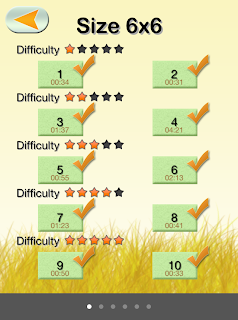Linesweeper might be the best of the bunch so far. It is similar to the popular Slitherlink, but different enough to be noteworthy.
The puzzle was actually invented a few years ago by +Jak Marshall, as mentioned on his blog.
I like closed loop puzzles, my favorite being Monorail, so it should be no surprise that I like Linesweeper too.
The play area is a grid containing some numbers. The grid is always square in this implementation of the puzzle, though it doesn't have to be.
The goal is to draw a closed loop on the board. The loop cannot pass through cells containing a number. The numbers indicate how many of the 8 neighbouring cells must be crossed by the loop. So the solution to the above puzzle would be:
Note that I had put a X between the 4 and 2, to remind that the loop cannot pass through that cell. The game allows to put both a X and a ? in any cell, simply by tapping it. The ? is supposed to indicate that the loop passes through the cell, but you don't yet know in which direction. To draw a segment of the loop, you simply swipe through a cell border. This works well and the game is intuitive to play, but I would have preferred if it used a dot instead of the ?, like tha Java version on janko.at does. Try #1 over there—I love the simplicity of that puzzle.
If you get stuck in a puzzle, you can quit and resume it later from where you left. Thumbs up for this too often omitted featured.
There are 50 free levels, with grid sizes from 6x6 to 10x10. Here is how a 10x10 looks like.
There are also ads. You can use a single in-app purchase to unlock 450 extra puzzles and remove ads.
I found the difficulty rating to be a bit hit and miss. For example here is how long it took me to solve the free 6x6 puzzles:
as you can see the difficulty rating didn't have much effect in my solving time, and actually one of the supposedly easiest puzzles is the one that took longest. On larger grids the effect of difficulty might be more noticeable, however my gut feeling is that the puzzles have been randomly generated and rated using some metric that makes sense for a computer solver, but doesn't directly relate to how humans solve the puzzle.
This is a fun logic puzzle, highly recommended for its mechanics, but I wish it had a more polished presentation and better difficulty classification.
Summary
| Nontrivialness | ★★★★☆ |
| Logical Reasoning | ★★★★☆ |
| User Interface | ★★★☆☆ |
| Presentation | ★☆☆☆☆ |
| Loading Time | ★★★★★ |
| Saves Partial Progress | ✔ |
| Status Bar | ✘ |
©2013 Nicola Salmoria. Unauthorized use and/or duplication without express and written permission is strictly prohibited. Excerpts and links may be used, provided that full and clear credit is given to Nicola Salmoria and nontrivialgames.blogspot.com with appropriate and specific direction to the original content.





